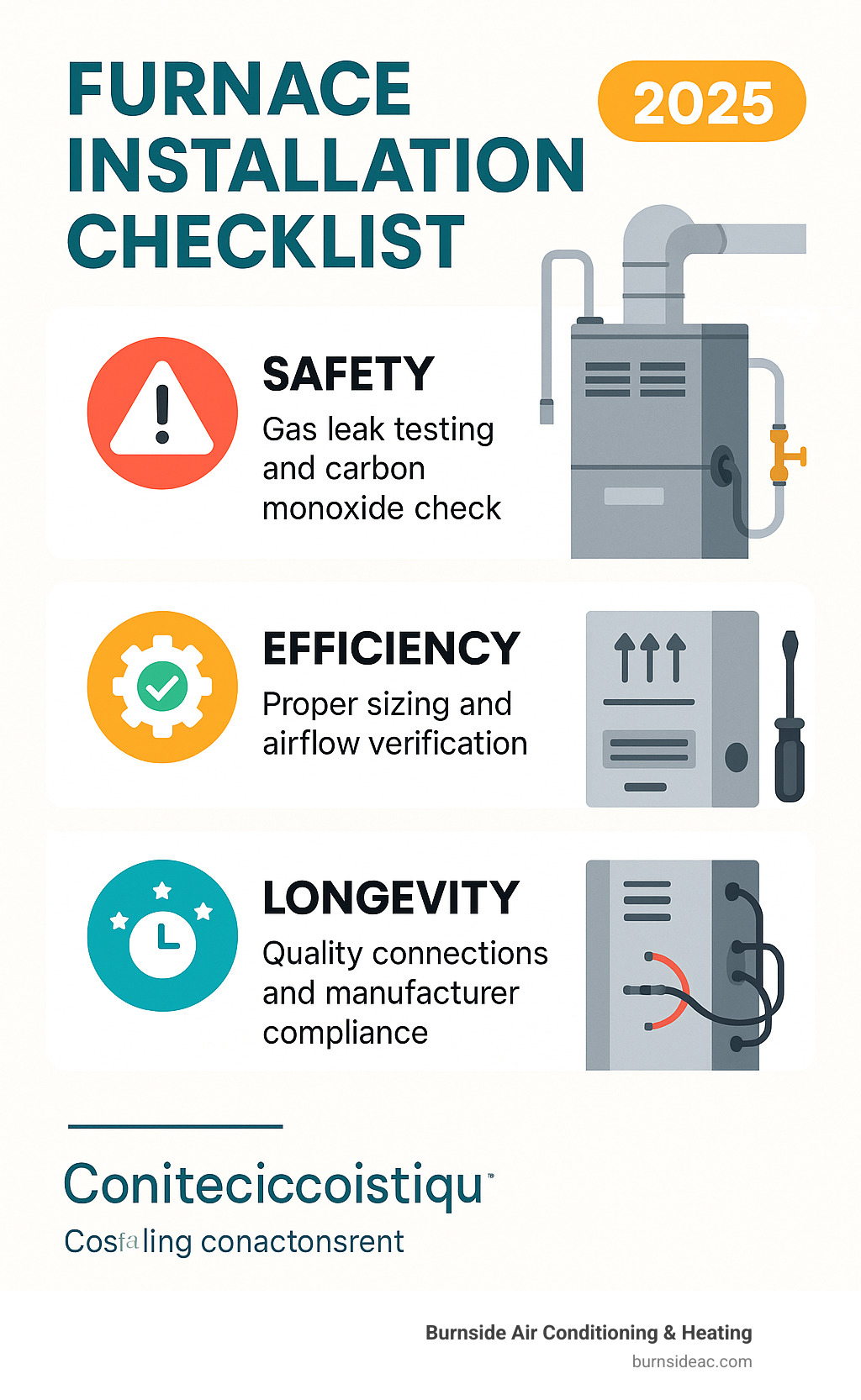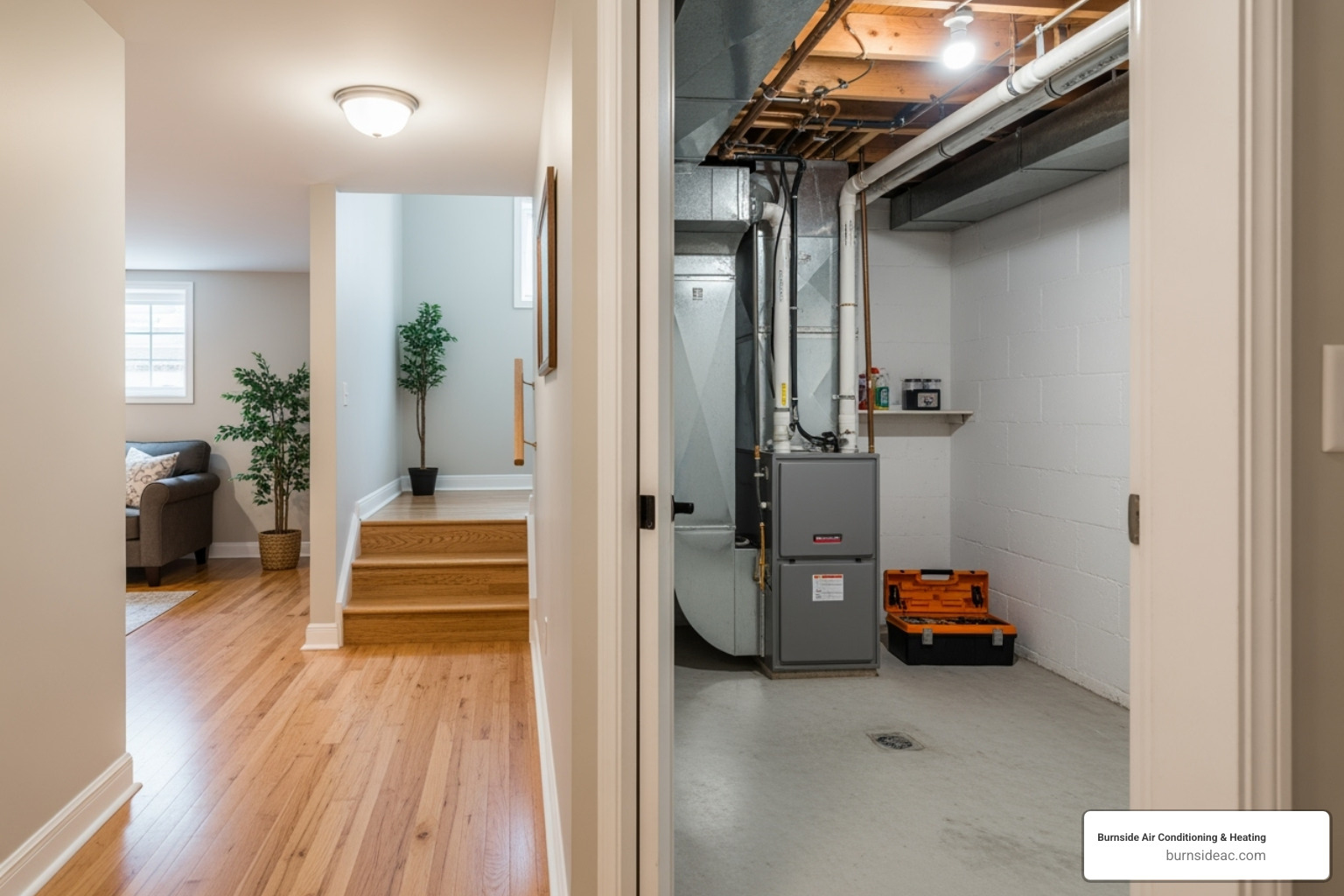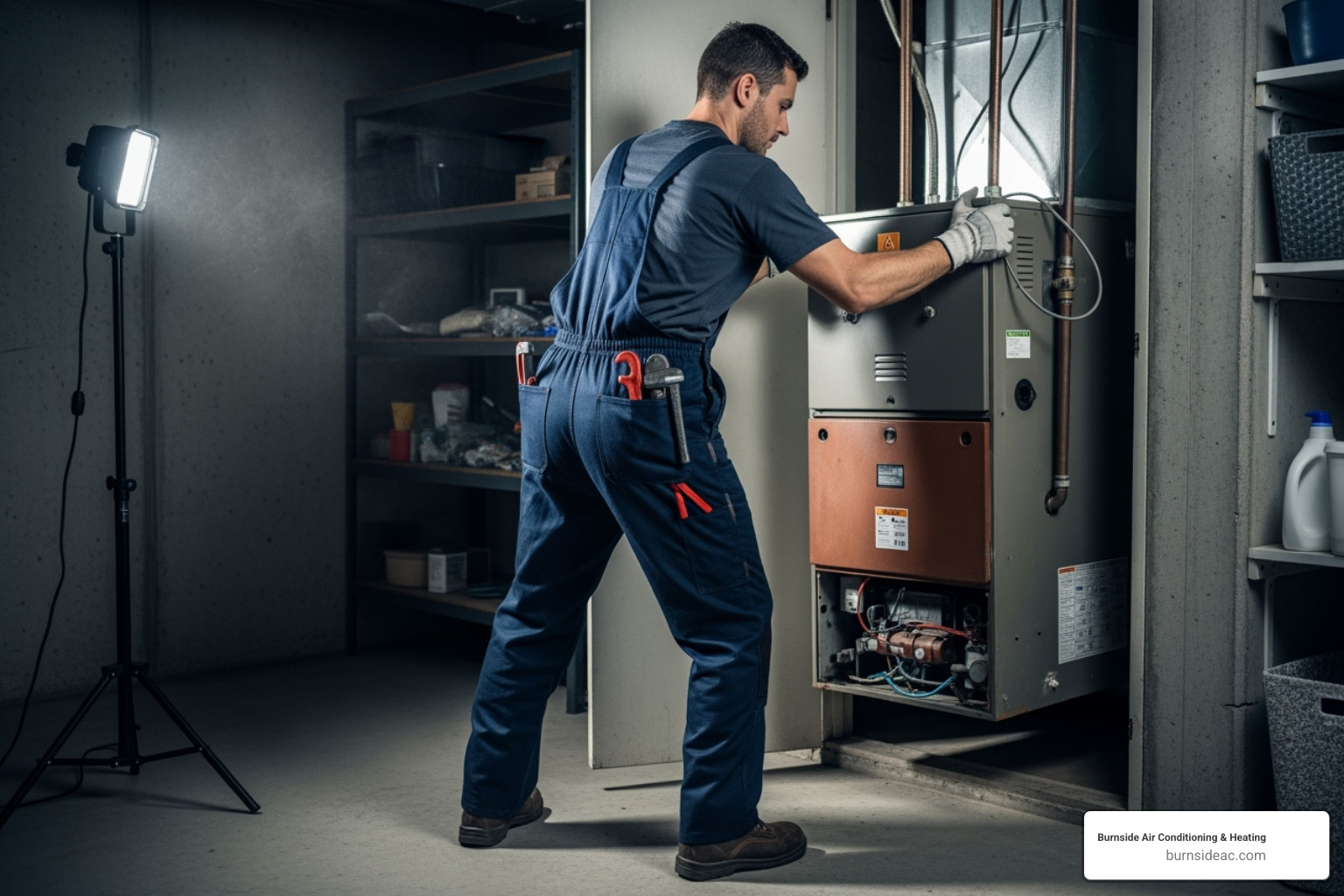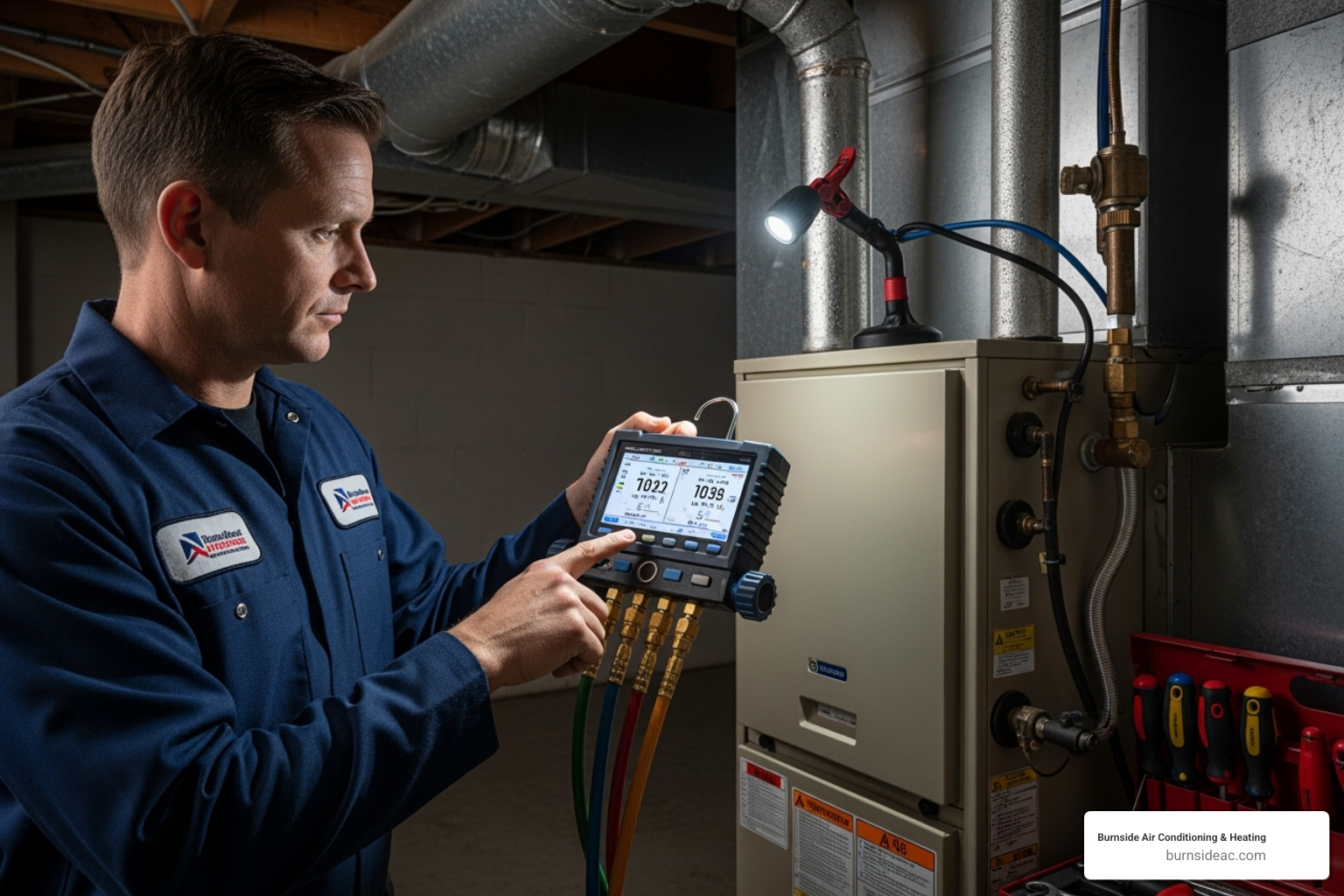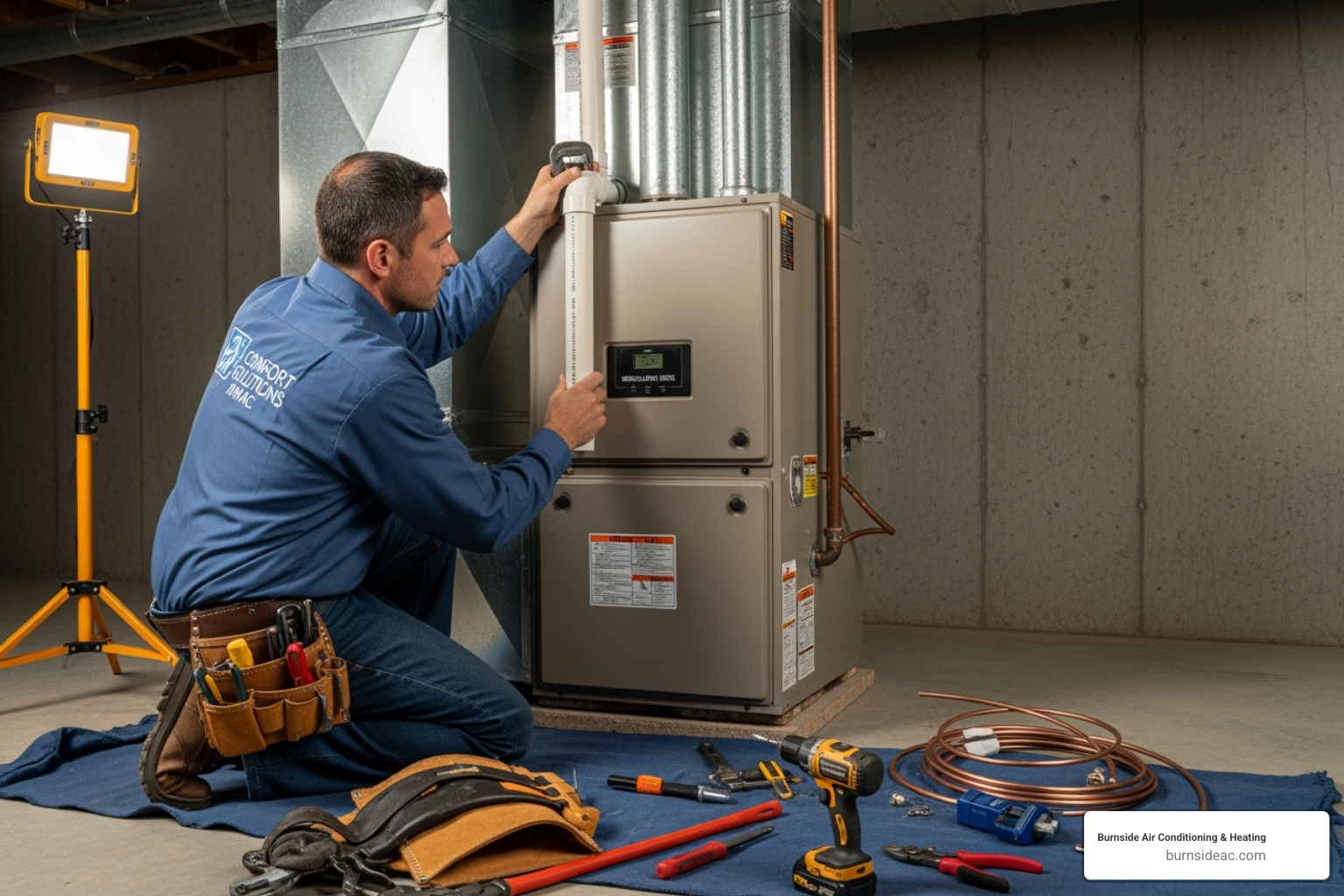
Why a Proper Furnace Installation Checklist Matters
A furnace installation checklist ensures your new heating system is installed safely, efficiently, and according to manufacturer specifications. Here are the essential steps every professional installation should include:
Pre-Installation:
- Manual J load calculation for proper sizing
- Obtaining necessary permits
- Clearing work area with 5-foot clearance
- Securing pets and planning technician access
Installation Day:
- EPA-certified refrigerant recovery from old system
- Professional removal of existing equipment
- New unit placement and electrical connections
- Gas line connection and venting installation
- Thermostat wiring and setup
Critical Testing:
- Gas leak detection
- Combustion analysis and carbon monoxide check
- Airflow verification and static pressure test
- Temperature split measurement (16-22°F difference)
- Final system cycling and performance verification
Post-Installation:
- Homeowner orientation and system demonstration
- Warranty registration and documentation
- Permit inspection scheduling
Your new system is a significant investment that should provide reliable warmth for years. Without proper installation, even the best furnace can fail prematurely or operate dangerously.
A comprehensive checklist protects you from surprise costs, ensures peak performance, and maintains your warranty coverage. Furthermore, regular maintenance inspections help avoid costly emergency repairs and ensure your system operates efficiently, leading to lower energy bills.
For Collin County homeowners, a proper installation checklist means peace of mind. You’ll know your system meets all safety codes, operates at maximum efficiency, and will provide reliable comfort for years ahead.
Phase 1: Pre-Installation Preparation – Setting the Stage for Success
Proper installation starts well before our crew arrives. This phase lays the foundation for years of reliable comfort, and the decisions made now will ensure a smooth process.
Choosing the Right System: Sizing and Type
Many homeowners mistakenly believe bigger is better when choosing a furnace. In reality, the right size is the only size that matters.
Proper furnace sizing starts with a Manual J load calculation. This involves precise engineering that considers your home’s square footage, insulation, windows, occupancy, and the local Texas climate. The ACCA Manual J standards guide this process to perfectly match the furnace to your home.
An oversized furnace will short-cycle, wasting energy and wearing out parts faster. An undersized furnace will run constantly trying to keep up, leading to high bills and premature failure.
When choosing between gas and electric furnaces, your home’s setup and local energy costs are key factors. Gas furnaces are a great choice in McKinney and Collin County, where natural gas is available. They typically cost less to operate and handle our cold snaps well. Electric furnaces can be highly efficient, but monthly bills depend on local electricity rates.
You’ll also hear about SEER2 ratings for newer systems, which help you understand energy efficiency. If you’re wondering whether your current system is ready for retirement, check out our guide on Signs Its Time for a Furnace Replacement.
Getting permits and scheduling your installation is part of our service. McKinney, TX, and most of Collin County require mechanical permits (and sometimes electrical or gas permits) to ensure installations are safe and up to code. We handle all the necessary paperwork and filing for you.
Once the paperwork is sorted, we’ll schedule the installation. Most replacements take four to eight hours, and we’ll provide a specific timeframe for your situation.
Homeowner’s Pre-Installation Furnace Installation Checklist
Your preparation helps ensure a smooth installation day:
Clear the work area around your existing furnace. We need at least five feet of clearance on all sides for installation and future maintenance.
Create a clear path from the entry to the furnace location. We’ll be carrying heavy equipment, so a clear path prevents damage and helps us work efficiently.
Secure pets and children for their safety. Please keep them away from the work area, tools, and equipment.
Plan for parking if you have preferences. A heads-up about any parking quirks helps us be better neighbors.
Gathering Information and Asking the Right Questions
Understanding your new system helps you care for it properly. Our technicians are happy to share their knowledge.
Essential questions every homeowner should ask include how to change the air filter, the recommended maintenance schedule, and how to operate the new thermostat. Also, ask what your warranty covers, as different parts have different coverage periods. Most manufacturers require warranty registration within 60 to 90 days.
Understanding your maintenance schedule upfront helps you budget and keep your system running efficiently. We’ll also provide efficiency tips specific to your new furnace.
For more detailed preparation tips, our AC Installation Appointment Guide covers many of the same principles.
The time you spend on this furnace installation checklist during preparation pays dividends. You’ll have the right system, properly sized and legally installed, with a clear understanding of how to keep it running smoothly.
Phase 2: Installation Day – What to Expect When the Crew Arrives
On installation day, our experienced team arrives ready to upgrade your home’s comfort system. Our process is designed to be as smooth and respectful as possible.
Our crew brings decades of experience and a commitment to treating your home with respect. The first step is always protecting your space.
Floor coverings and site protection happen immediately. We lay down protective materials from your entry door to the work area to ensure your floors and walls stay pristine.
Removing your old equipment begins with carefully disconnecting all electrical, gas, and ductwork connections.
If your old system includes an air conditioner, federal law requires EPA-certified refrigerant recovery to protect the environment. Our certified technicians handle this responsibly. You can learn more about these important regulations at EPA Refrigerant Regulations.
We then dismantle the old furnace methodically to prevent any damage to your home, navigating even tight spaces with care.
Ductwork inspection and modification is a crucial next step. Our technicians examine your existing ductwork for leaks, proper sizing, and overall condition. We’ll make any necessary modifications to ensure proper airflow and maximum performance from your new, more efficient system.
Key Steps in a Professional Furnace Installation
Installing your new system involves several key steps from our furnace installation checklist designed for safety, efficiency, and reliability. For a comprehensive look at our process, visit our Key Steps in Furnace Installation page.
Placing the new unit requires precision. The furnace must sit on a solid, level surface with at least five feet of clearance from combustible materials for safety and proper air circulation.
Electrical connections are made according to the National Electrical Code (NEC) and local regulations. We secure all wiring, ensure proper grounding, and seal electrical openings to prevent air leaks.
For gas furnaces, the gas line connection is critical. We connect supply lines with meticulous attention to detail, install a drip leg (sediment trap), and perform comprehensive gas leak testing.
Venting and flue pipe installation ensures the safe expulsion of combustion byproducts. We install the flue pipe with the correct slope and clearances and seal all ductwork connections to prevent carbon monoxide leaks.
High-efficiency condensing furnaces require a condensate drain line, which we install with a trap and overflow safety switch to prevent water damage.
Finally, thermostat wiring connects the command center to your new system, ensuring it communicates perfectly for precise temperature control.
These detailed steps reflect our comprehensive approach, which you can learn more about in our Heating Installation Steps We Take guide.
Your Complete Furnace Installation Checklist: From Start to Finish
This critical testing phase separates a professional installation from a rushed job. Our furnace installation checklist includes comprehensive safety and performance checks to ensure your system is ready to keep your family comfortable and safe.
Critical Safety and Performance Checks
Once physical connections are made, our technicians perform a thorough examination. This critical phase can take an hour or more.
Gas leak testing is our first and most critical safety check for gas furnaces. We use sensitive electronic detectors to check every joint and fitting for even the tiniest gas leaks, ensuring your home’s safety.
The combustion analysis measures how cleanly your furnace burns fuel. Using digital analyzers, we check for safe levels of oxygen, carbon dioxide, and especially carbon monoxide (CO) to prevent dangerous situations.
Electrical safety checks are vital. We verify that every wire is secure, the electrical load is correct, and all grounding is in place to prevent fire hazards.
Airflow verification ensures optimal comfort and efficiency. We measure the volume of air your system moves and perform a static pressure test to see how hard it works to push air through your ducts. High static pressure is inefficient and causes unnecessary wear.
These checks align with industry standards like the ACCA Quality Installation Standard, ensuring your installation meets the highest professional benchmarks.
System Startup and Final Testing
Next, we start up the new system to put it through its paces.
For systems with cooling, refrigerant charging is done with precision. We measure superheat and subcooling to ensure the system has the exact amount of refrigerant for optimal performance.
The temperature split test proves the system is working as designed. We measure the air temperature entering and leaving the furnace to confirm it’s transferring heat efficiently. For AC, a 16-22°F temperature difference between return and supply air indicates proper cooling.
Thermostat verification ensures the controls communicate perfectly with the furnace. We test all modes, settings, and programmable features.
System cycling involves running the furnace through multiple on-and-off cycles to check for smooth startups and listen for any unusual sounds. Any issues are addressed immediately.
Finally, we handle the final cleanup. All debris is removed, protective coverings are taken up, and the work area is left tidy.
This level of thoroughness is possible because our team invests in continuous education, as reflected in the fact that our HVAC installers complete 100 hours of training every year.
Phase 3: Post-Installation – Final Steps and Future Care
The installation is complete, but our work isn’t done. This final phase ensures you’re comfortable with your new system and prepared for years of reliable warmth.
Technician’s Post-Installation Furnace Installation Checklist
Before our crew leaves, they complete one final step from our furnace installation checklist: your homeowner orientation.
Our technicians provide a complete system operation demo, showing you how everything works, from basic functions to thermostat settings. We want you to feel confident managing your new heating system.
Next is the maintenance explanation. We’ll show you how and when to change the air filter, a simple step that significantly impacts efficiency and longevity. We’ll also discuss annual professional tune-ups to catch minor issues early. If you’re curious about getting your system ready for the heating season, check out our guide on how to Prepare Fall New Heating System.
Finally, we’ll answer any final questions you have about system operation, energy-saving tips, or anything else. We want you to get the most out of your investment.
Documentation and Warranty
You’ll receive a complete set of documents for your new furnace.
Your final invoice will clearly detail all work performed. The manufacturer’s warranty information outlines what’s covered and for how long. Many manufacturers require online registration within 60 to 90 days, and we can help guide you through this process.
You’ll also receive a detailed commissioning report. This document shows the results of all performance tests (temperature splits, pressure readings, combustion analysis), proving your system was installed to the highest standards.
The permit inspection details ensure everything is compliant with your local municipality. We handle scheduling the inspection and provide all necessary documentation. You’ll also get a copy of your completed furnace installation checklist as a comprehensive record.
For additional insights, the Energy Star – HVAC Installation Checklist provides helpful information about professional installations.
With this documentation, you can rest easy knowing your furnace was installed correctly.
Frequently Asked Questions about Furnace Installation
Getting a new furnace is a big investment in your family’s comfort. Here are answers to the questions we hear most often from homeowners.
How long does a furnace installation take?
A standard furnace replacement typically takes between 4 to 8 hours. The exact time depends on a few factors.
A simple replacement in the same location with good ductwork is on the shorter end of that timeframe. However, complex installations or ductwork modifications can extend this time, such as when upgrading to a high-efficiency system with new venting or combining the job with an AC installation.
Your contractor should provide a specific timeframe before work begins. We assess what needs to be done and give you a realistic estimate for quality work.
Do I need a permit for a furnace installation in Texas?
Yes, most jurisdictions in Texas, including McKinney and Collin County, require a mechanical permit for furnace installations. This is a good thing, as it ensures the work is done to code and inspected for safety, providing an extra layer of protection for your family.
Sometimes an electrical permit is also needed for significant electrical work.
Your HVAC contractor should handle the permitting process. We take care of all paperwork, applications, and inspection coordination, ensuring everything is done properly.
What are the most common installation mistakes to avoid?
A proper furnace installation checklist helps avoid these common pitfalls:
Improper sizing is a major error. A furnace that’s too big will short-cycle, wasting energy. One that’s too small will run constantly. We always perform Manual J load calculations to ensure correct sizing.
Faulty ductwork connections leak heated air, leading to major efficiency losses. We inspect and seal every connection.
Incorrect venting is dangerous and can lead to carbon monoxide problems. We follow strict guidelines for safe venting.
Poor electrical wiring is a safety hazard. Our electrical work follows the National Electrical Code, with proper grounding and secure connections.
Skipping a final system test means you can’t be sure the system is working safely and efficiently. We always perform thorough testing.
Choosing an unlicensed or uninsured contractor can void warranties, create hazards, and lead to premature system failure. Always verify a contractor’s credentials.
A quality installation by experienced professionals prevents these problems. That’s why we’ve been serving McKinney and Collin County families since 1958—we do it right the first time.
A Smooth Installation for a Warm and Comfortable Home
Following a comprehensive furnace installation checklist is an investment in years of reliable comfort and peace of mind. Every step, from the Manual J load calculation to final testing, ensures your new furnace operates safely, efficiently, and durably.
A properly sized and installed furnace heats your home evenly without wasting energy. Safety checks like gas leak testing and carbon monoxide monitoring protect your family, while airflow and pressure tests lead to lower energy bills and fewer repairs.
A detailed checklist ensures nothing is overlooked. You can relax on installation day, knowing every connection will be secure, every safety protocol followed, and every performance test completed.
For homeowners in McKinney, TX, and Collin County, choosing the right contractor is just as important as the checklist. You need an experienced company that stands behind its work.
As a family-owned business since 1958, Burnside Air Conditioning & Heating has perfected our craft. We adapt our installation practices to the highest industry standards as heating technology evolves. When you trust us with your furnace replacement in McKinney, TX, you’re getting the confidence that comes from guaranteed workmanship and a commitment to doing things right the first time.
Your home deserves the comfort and efficiency that comes from a properly installed furnace. With the right checklist and the right team, that’s exactly what you’ll get.
